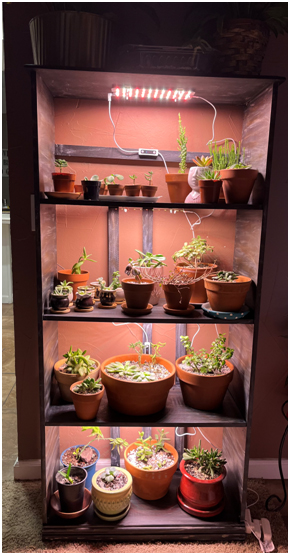By Debbie Roland and
Emmy Ulmschneider
Master Gardeners
The last few years succulents have skyrocketed in popularity. We hear people say that they love them and have them all over their house while other says they just can’t seem to grow them at all. They are beautiful with many different plant varieties and quite simple if you just follow these rules:
Some gardeners believe that since they look like cactus that they should grow well in the West Texas sun. However, they don’t do well in any temperature above 80 degrees whether they are indoors, on perhaps a sun porch, or outdoors. They also do not thrive if their soil stays wet. Water once a week in summer, every other week in fall and spring, and only once a month during the winter since that is their dormant period. They must have good drainage.
Fertilize twice during the spring using a diluted (to half strength) liquid fertilizer.
To have balanced growth, morning sun is best for succulents with shade the rest of the day. They will not live if left in the West Texas direct sun. You will know if you have left them in too much sun because they will get brown or beige patches which is sunburn and can kill the plant.

When planting you can use a cactus mix but it is expensive. To make your own, mix 1/2 potting soil and 1/2 pumice.
If your plants are outside, you can prevent pests by giving them good circulation. If you notice pests, such as aphids, spray with 70% rubbing alcohol mixed with 50% water. If you think the plant is too far gone simply take a cutting of an unaffected area and put it in a fresh pot with fresh soil. Discard the affected plant and potting soil, and wash the pot with diluted bleach water so you can reuse it.
You can grow succulents indoors and they thrive. Below are pictures of Debbie’s daughter-in-law, April Ward’s, succulent garden in her home office.
The word succulent comes from the Latin word sucus, meaning ‘juice’, or ‘sap’ and succulents store water in various structures, such as leaves and stems. In addition to being adapted to water storage, they are native to either deserts or areas that have a semi-arid season. In horticultural use, the term succulent is sometimes used in a way that excludes plants that botanists would also regard as succulents, such as cacti which store water in their stems.
So, are there native succulents? Here in West Texas, we are already familiar with succulents such as red yucca, agave, sotol, and nolina. Regardless of how we use the term, we value succulents because of their striking and unusual appearance, as well as their ability to thrive with relatively minimal care. In my yard, I value my native succulents for their eye appeal and their value to provide food, water and shelter to the animals that inhabit my urban yard.
So regardless of whether you grow them inside or out, know that when you do you are conserving a vital resource: water.
For more information, call the AgriLife office at 498-4071 in Odessa or at 686-4700 in Midland or visit aggie-horticulture.tamu.edu or westtexasgardening.org.




